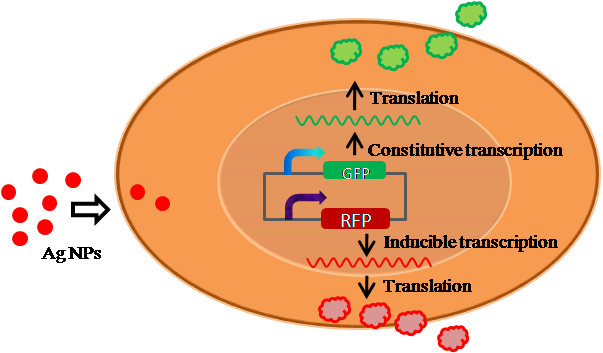
With the expanding use of engineered nanoparticles (NPs), nanomaterial toxicity is becoming an increasingly important issue in nanotechnology. In the interests of biosecurity, it is important to develop a high-throughput and sensitive method to evaluate NP safety.
Given this, a study team led by Prof. WU Lijun in Institute of Technical Biology & Agriculture Engineering, Hefei Institutes of Physical Science (CAHIPS) of the Chinese Academy of Sciences, developed cell-based biosensors to efficiently monitor nanoparticletoxicity.
In the study, three cell-based biosensors were developed to efficiently and conveniently monitor NP toxicity. The biosensor cells were obtained by transiently transfecting human cells with biosensor plasmids, which contains a mCherry gene regulated by an inducible promoter [an activator protein 1 (AP-1) promoter, an interleukin 8 (IL8) promoter, or a B cell translocation gene 2 (BTG2) promoter], with an enhanced green-fluorescent protein gene driven by the cytomegalovirus promoter as the internal control.
After optimizing flow cytometric analysis, these dual-fluorescence cell-based biosensors possess the capability to accurately and rapidly detect NP toxicity.
Researchers found that the responses of AP-1, BTG2, and IL8 biosensors in assessing the toxicity of silver nanoparticles (Ag NPs) showed good dose-related increases after exposure to Ag NPs and were consistent with data acquired by conventional assays, such as western blot, real-time polymerase chain reaction, and immunofluorescence.
In addition, further investigation of the effects of environmental factors on Ag NP toxicity revealed that aging in water, co-exposure with fulvic acid, and irradiation with ultraviolet A light could affect Ag NP-induced biosensor responses.
These findings suggested that novel dual-fluorescence biosensors can be applied to accurate and sensitive monitoring of NP toxicity.
The study entitled Development of dual-fluorescence cell-based biosensors for detecting the influence of environmental factors on nanoparticle toxicity was published in Chemosphere.
This work was supported by the Major National Scientific Research Projects, the Strategic Leading Science & Technology Program, the Major/Innovative Program of Development Foundation of Hefei Center for Physical Science and Technology, and the CAS/SAFEA International Partnership Program for Creative Research Teams.

Figure 1. Schematic drawing of detecting the toxicity of nanoparticels with the dual-fluorescent biosensor system. (Image by LIANG Junting)

86-10-68597521 (day)
86-10-68597289 (night)

52 Sanlihe Rd., Xicheng District,
Beijing, China (100864)

